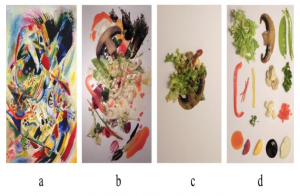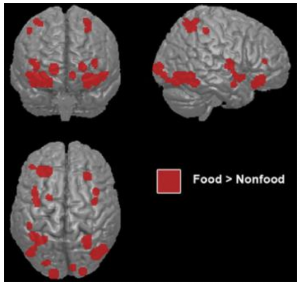Collaborators: Olivia Petit, Adrian David Cheok
Abstract
From ancient times through still life to taking pictures of dishes in restaurant on Instagram (i.e. smartphone application) or more generally through so called “Food Art”, humans have always seeking to represent food in an aesthetic form (Fig. 1). Food is an important part of everyday life and the emotional reactions, which it produces plays a role in the determination of the expected pleasure of consumption, the hunger and the satiety. Considering food as art leads to ask the question of the possibility of an aesthetic judgment on the food, independently of its functional feeding function and taste inferences it can produce. The development of neuroimaging techniques, allowing analyzing the brain activity changes during the presentation of artwork, sheds new light on these relationships. Several functional neuroimaging studies have indeed been conducted to determine the brain regions associated with aesthetic judgments (median orbitofrontal cortex, posterior parietal cortex, premotor cortex, ventral striatum, Fig. 2) during the presentation of artwork (e.g. painting, statue, music) and other studies have highlighted the taste areas (orbitofrontal cortex, frontal operculum, insula, gyrus fusiform) solicited by the vision of food (Fig. 3). Thus future studies might compare for different forms of artistic representations of food if they are closer to the aesthetic judgment or closer to the taste judgment (Fig. 4). The conduct of this type of experiment might help to better understand the artistic dimension of food.
Keywords: Food, Art, Aesthetic reaction, fMRI
Fig. 1. The Kandinsky painting used as the inspiration for the dish (a), the ‘art-inspired’ condition (b), the ‘regular’ condition, the ‘neat’ condition (c, Michel et al. 2014).
Fig. 2. Activations in VS (ventral striatum), OFC (orbitofrontal cortex) and CBL (cerebellum) for art images compared to non-art images (Lacey et al., 2011).
Fig. 3. The results of the meta-analyses for the contrast food > non-food (van der Laan et al., 2011).
Fig. 4. fMRI paradigm is a block design (6 similar images order with 2s image presentation and 0.2s fixations between each image), realized in 4 runs (pseudo-randomized order of 36 blocks with 2s fixations between each block) for 37 minutes, comparing BOLD fMRI response in 6 conditions. A. scrambled pictures. B. location pictures. C. landscape paintings. D. food in plate pictures. E. food paintings. F. creative plate pictures.




